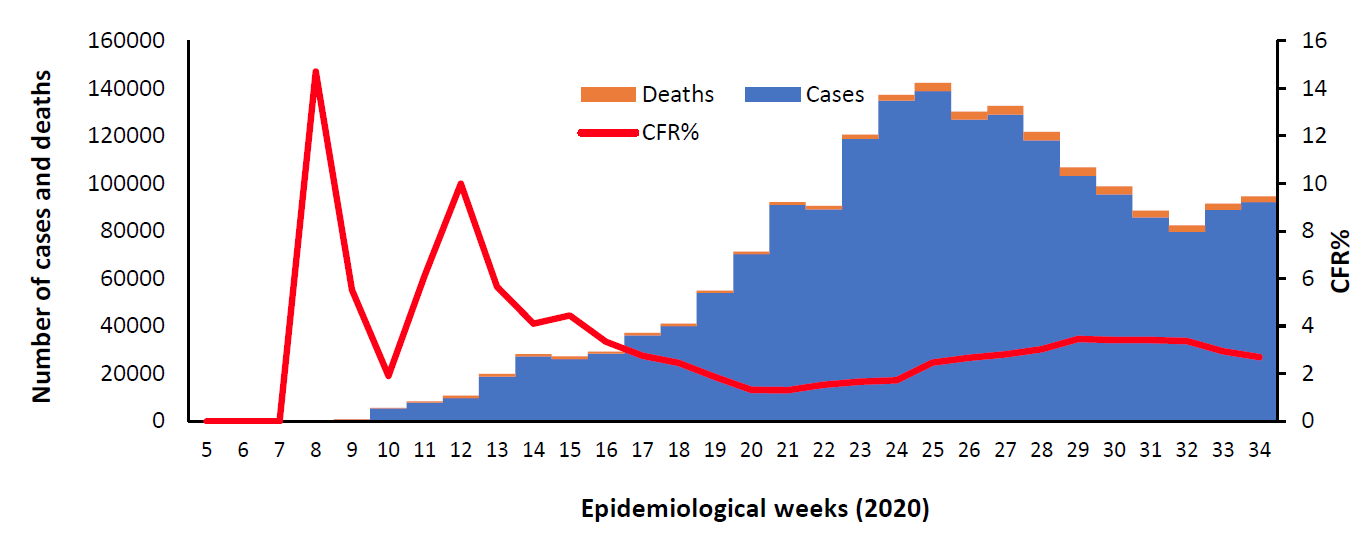The coronavirus disease COVID-19 has been spreading for more than 7 months, and it continues to accelerate at regional and global levels. As of 22 August 2020, the global cumulative incidence reached 22 812 491 reported cases and 795 132 associated deaths with a case fatality ratio (CFR) of 3.5%. The cumulative mortality incidence exceeded 750 000 deaths on August 15, with the second highest daily death total to date at 10 008 new deaths. Meanwhile, the 22 countries of the Eastern Mediterranean Region (EMR) have reported a total of 1 816 161 cases, which represent about 7.9% of the global count, with 48 191 associated deaths (CFR 2.7%). Most countries in the Region are in the community transmission phase.
Since the beginning of the outbreak, the country that has reported the highest number of total cases in the Region is Islamic Republic of Iran (356 792 cases; 19.6% of the Region’s total), followed by Saudi Arabia (306 370; 16.9%) and Pakistan (292 765; 16.1%). Islamic Republic of Iran also reported the highest number of total associated deaths (20 502; CFR 5.7%) followed by Iraq (6353; CFR 3.2%) and Pakistan (6235; CFR 2.1%). The highest CFRs were reported by Yemen (28.6%) followed by Sudan (6.4%), while the lowest CFRs were reported by Qatar (0.2%) followed by Bahrain (0.4%).
During epidemiological week 34, the Region reported a 3.6% increase in cases when compared to the previous week (92 077 cases compared to 88 910 cases). However, a 4.9% reduction was observed for associated deaths (2481 deaths compared to 2610 deaths). The weekly trend per capita showed slight increase as compared to the previous week (248.5 compared to 235.9 /100 000).
Lebanon, Libya and Syria reported relative increase in COVID-19 activity. The number of cases in Lebanon increased from 8442 to 11 580 (37% increase compared to the previous week), Libya from 7738 to 10 121 (31% increase) and Syria from 1593 to 2073 (30% increase). Syria, Morocco and Libya had the largest relative increase in deaths (38%, 29% and 24%, respectively). Egypt, Oman, Pakistan and Somalia have reported less than 1 effective reproductive rate (Rt) for more than 2 weeks.
In terms of testing, a total of 24 520 053 laboratory PCR tests were conducted since the start of the outbreak across the Region including 1 851 041 tests in week 34, which shows a 1% increase compared to previous week (1 837 868). The highest number of PCR tests were reported from United Arab Emirates (6.4 million), followed by Saudi Arabia (4.6 million) and Islamic Republic of Iran (3 million). The United Arab Emirates and Bahrain are performing the highest rate of testing per capita (64 893/100 000 and 60 530/100 000, respectively). The average positivity rate for the Region is 7.4%. WHO recommends a positivity rate of around 3–12% as a general benchmark indicating adequate testing, which was achieved in most countries of the Region.
The regional incident management support team continues to coordinate the response and provide technical support to countries and partners in the Region in the areas of coordination and partnership, surveillance, laboratory capacity, clinical management, infection prevention and control (IPC), risk communication, points of entry according to the International Health Regulations (2005), research, health system, essential health services and others. Sudan and Syria have been supported in scaling up their testing capacities through decentralization at the subnational level and strengthening national laboratory networks to allow timely access to testing in all parts of each country. A procurement and distribution plan for laboratory diagnostics has been developed to ensure the availability and continuity of the supply chain in Syria. The ninth webinar of the COVID-19 Laboratory Community of Practice was conducted with a focus on the use of the Influenza surveillance system for COVID-19 surveillance. Webinars were also held to orient national technical working groups towards the planning and implementation of national adolescent health strategies and plans in line with the Global Accelerated Action for the Health of Adolescents (AA-H!). These were conducted for Afghanistan, Iran, Iraq, Palestine and Syria.
The fifth regional meeting on COVID-19 and migration was held. The mental health and psychosocial support (MHPSS) platform was updated with a new module for frontline workers. A webinar was also help for UN partners on the rapid assessment of the impact of COVID-19 on MHPSS service delivery.
In the meantime, a 5 day training of trainers started this week to train IPC practitioners in Punjab Province of Pakistan, which is attended by 35 participants. An IPC consultant was deployed on a mission to Pakistan for three week to support the improvement of IPC at the national and provincial levels.

For more data from the Region, please visit the COVID-19 dashboard.
Subscribe to the monthly infectious hazard preparedness newsletter of WHO’s Health Emergencies Programme for latest data and analysis on epidemic- and pandemic-prone diseases, as well as news on outbreak preparedness and response within WHO’s Eastern Mediterranean Region.




